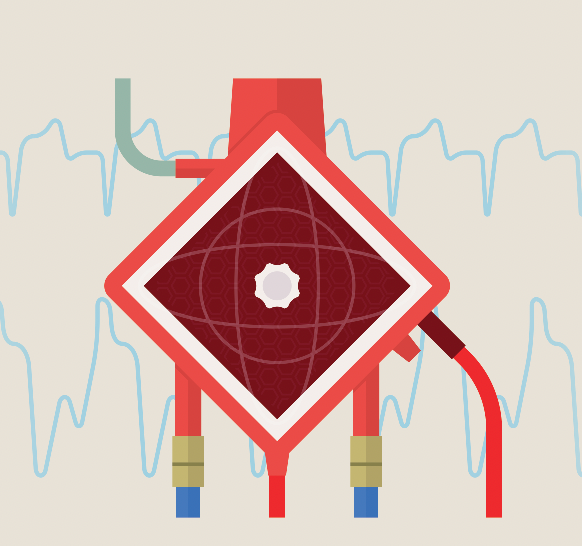
The use of extracorporeal membrane oxygenation (ECMO) in critically ill patients has steadily increased over time1 and is expected to continue to grow in adult patients with recent inclusion of ECMO in 2 societies’ guidelines for acute respiratory distress syndrome (ARDS) management.2,3 These critically ill patients in intensive care units are vulnerable to nosocomial infections secondary to multiple ECMO-specific risk factors. As we celebrated the 100,000th patient discharged alive after ECMO treatment in 2022,1 what have we learned so far about ECMO-associated infections (EAIs) and how can infectious diseases physicians improve care for EAIs in the future?
One of the many challenges to studying EAIs is the lack of a universal definition. The reported rate of infection while on ECMO varies from 28.6 to 113 per 1000 ECMO-days depending on the study.4 One important factor that partially explains the variance in infection rate stems from the heterogeneity of definitions used for EAI. Currently, there is no standard definition of EAI provided by the Extracorporeal Life Support Organization (ELSO) and the most commonly used definitions in literature are from the Centers for Disease Control and Prevention/National Health Safety Network (NHSN).5 Hospitals currently collect data on central-line‒associated bloodstream infection (CLABSI) and ventilator-associated event rates, but these patients are excluded from any calculations by NHSN.5 Data on EAIs are primarily from single-center studies with significant bias in their reporting of infections. To overcome these hurdles, a recent systematic review suggested 6 essential reporting elements when performing studies on EAIs: (1) standardized rates of infection per 1000 ECMO-days, (2) antimicrobial prophylaxis strategies used, (2) infection control practices in place, (4) description if culture was collected based on clinical criteria or as surveillance, (5) definition of infection, and (6) microbiology by site of infection.4 We believe these elements are key first steps in establishing clear consensus definitions on EAI by guideline-making organizations. With uncertainty in definitions, infectious diseases physicians have experience distinguishing infections from colonization and should be central figures both at local institutions and on national committees evaluating EAIs.
Why is it challenging to define EAIs? In addition to the lack of universal definitions, clinical markers poorly identify infections. Verkerk et al investigated the concurrence rate of 3 intensivists evaluating potential EAIs.6 They found that among the clinical episodes that the first rater thought was due to infection, the other 2 raters agreed with them in only 54% of cases,6 demonstrating how puzzling it could be to make a diagnosis of EAIs. Vazquez-Colon et al reviewed challenges of using conventional signs, symptoms, and tests to diagnose infections while the patient is on ECMO.7 For example, when the indication for ECMO is ARDS, chest X-ray will give little information about new pulmonary infiltrates. Due to both heating and cooling elements, as well as the significant volume of blood outside the body, abnormal body temperature has poor specificity in identifying EAIs.8 Because of the inflammatory nature of the ECMO circuit, leukocytosis, C-reactive protein, and procalcitonin have low specificity for infections due to leukocyte modulation effect of ECMO circuit.8-10 Finally, regarding cultures, understanding when they are appropriate to collect and interpreting the significance of the positive results (infection vs contamination vs colonization) remains as a major challenge.7 Infectious diseases physicians have experience balancing often contradicting clinical markers to diagnose infections and should be on the front line determining which criteria should be considered for diagnosing EAIs. It is understandable that clinicians fear missing a potential infection considering the difficulty with diagnosis of EAIs and the morbidity and mortality associated with them. This leads to practices such as daily surveillance blood cultures or variable implementation of biomarker surveillance at some ECMO centers. This is where infectious diseases providers need to pause and evaluate the utility of such practices with emphasis on diagnostic stewardship and its downstream impact on antimicrobial stewardship. Overdiagnosis of EAIs leads to prolonged use of broad-spectrum antibiotics, which comes with well-known costs such as Clostridioides difficile colitis, emergence of multidrug-resistant organisms, and acquisition of hospital-associated microbiologic colonization.
One proposed algorithm for infectious workup in adult patients on ECMO (FIGURE 1)11 puts emphasis on exploration of alternative noninfectious diagnoses, judicious use of diagnostic tests guided by likely focus of disease process, de-escalation of antibiotic spectrum when cultures are available, and setting an end date for antibiotic duration.11 We believe this could provide practical guidance to clinicians managing ECMO patients and give impetus to large database reviews by guidelines defining organizations to further define EAIs.

From a management standpoint, there are broadly 2 ways antimicrobials are used in ECMO patients: prophylaxis and treatment. Current ELSO guidelines provide no standard policy regarding prophylactic antibiotics for ECMO patients.12 While there is a lack of consensus, many centers routinely use antimicrobial prophylaxis of varying spectrums with ECMO. To date, retrospective studies have not shown improved patient outcome with antimicrobial prophylaxis used after ECMO cannulation.13 While data are lacking, best practices for prophylactic antimicrobials, if used, would be to tailor the spectrum of antimicrobial prophylaxis to the risk profile of patients in that particular center. Ideally, local guidelines for antimicrobial prophylaxis should be tailored according to geographic differences in microbiology, antibiograms, infection prevention and control policy, ECMO device, and cannulation techniques.
This process requires close involvement of local infectious diseases experts. Reduce AMMO study is an example of a successful multidisciplinary effort pivoted by infectious diseases clinicians to optimize ECMO antimicrobial prophylaxis practice at a large tertiary hospital.14 In this study, the authors developed standardized prophylaxis protocol based on the institution’s infection data and successfully tailored ECMO prophylaxis to patient EAI risk, without increase in infection rate or therapeutic antimicrobial use. At ECMO centers, infectious diseases physicians should be working closely with the critical care teams on best practices, knowing the risk factors at their individual centers.
For treatment of EAIs, a general rule of thumb is that the choice and duration of antimicrobials should be directed by focus of infection, available microbiologic data, and clinical course while balancing risks and benefits of the selected approach. With scant patient outcome data, it is reasonable to treat most pneumonia syndromes while on ECMO with 7 days of culture-guided antimicrobials, but the duration could be adjusted individually considering patient and pathogen factors.11 The concern with bloodstream infections (BSIs) in ECMO patients is that ECMO cannulas or the ECMO circuit can be colonized and infected just as other CLABSIs, except it is more difficult or sometimes impossible to replace these circuit components if the patient has ongoing ECMO need. Indeed, studies have shown that 30% to 40% of patients who remained cannulated after completing antimicrobials for BSI had recurrence of bacteremia or fungemia.15,16 Given high recurrence rate, ECMO patients with BSIs should receive repeat blood cultures when removal of cannulas is not possible, and optimal duration of antimicrobial course in these circumstances warrants further study.11 While certain infections show improved mortality with infectious diseases consultation, for the complex patients with EAIs, infectious diseases physicians should be closely involved.
Finally, antimicrobial dosing poses a unique challenge when treating infections in ECMO patients. Sequestration of antimicrobials in the ECMO circuit can lead to substantial variations in pharmacokinetics (PK).17,18 Antimicrobials with high lipophilicity and protein binding are expected to be most affected by ECMO; however, this theoretical prediction is often discordant with real-life patient PK and pharmacodynamic (PD) data. In addition, patients receiving ECMO have multiple confounding factors that could affect antimicrobial dosing, such as fluid retention, hypoalbuminemia, and renal and hepatic dysfunction. Outside of observational PK/PD data, patient outcome data in antimicrobial dosing with ECMO are limited to case studies.
Therapeutic drug monitoring will be highly valuable in individualizing antimicrobial dosing strategy in these patients with dynamic physiology. There should be consideration of an alternative evidence evaluation strategy to gauge evidence of antimicrobial dosing while on ECMO, as large-scale prospective, blinded, randomized controlled trials may not be possible in this patient population. Recently, Kriegl et al published an excellent review article on dosing of antifungals in ECMO patients.19 Our group is leading work on a review document encompassing antifungals, antibacterials, and antivirals, which is forthcoming in the near future. To provide practical suggestions for antimicrobial dosing in ECMO, a comprehensive semiquantitative summary of the existing literature is needed.
We conclude that significant research efforts are needed to better define, diagnose, prevent, and treat EAIs. We call for infectious diseases specialists around the globe to collaborate in this challenge to manage and research EAIs in diverse patient populations. Lastly, we urge guideline-driving organizations to consider establishing standardized definitions and reporting systems for EAIs to facilitate advancement in our understanding and management strategies.








